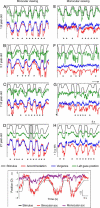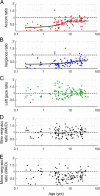Cues for the control of ocular accommodation and vergence during postnatal human development
- PMID: 19146280
- PMCID: PMC2643357
- DOI: 10.1167/8.16.14
Cues for the control of ocular accommodation and vergence during postnatal human development
Abstract
Accommodation and vergence help maintain single and focused visual experience while an object moves in depth. The relative importance of retinal blur and disparity, the primary sensory cues to accommodation and vergence, is largely unknown during development; a period when growth of the eye and head necessitate continual recalibration of egocentric space. Here we measured the developmental importance of retinal disparity in 192 typically developing subjects (1.9 months to 46 years). Subjects viewed high-contrast cartoon targets with naturalistic spatial frequency spectra while their accommodation and vergence responses were measured from both eyes using a PowerRefractor. Accommodative gain was reduced during monocular viewing relative to full binocular viewing, even though the fixating eye generated comparable tracking eye movements in the two conditions. This result was consistent across three forms of monocular occlusion. The accommodative gain was lowest in infants and only reached adult levels by 7 to 10 years of age. As expected, the gain of vergence was also reduced in monocular conditions. When 4- to 6-year-old children read 20/40-sized letters, their monocular accommodative gain reached adult-like levels. In summary, binocular viewing appears necessary under naturalistic viewing conditions to generate full accommodation and vergence responses in typically developing humans.
Figures











References
-
- Adamson J, Fincham EF. Effect of lenses and convergence on the state of accommodation of the eye. Transactions of the Ophthalmological Society. 1939;59:163.
-
- Alpern M, Ellen P. A quantitative analysis of the horizontal movements of the eyes in the experiment of Johannes Mueller. I. Method and results. American Journal of Ophthalmology. 1956a;42:289–296. [PubMed] - PubMed
-
- Alpern M, Ellen P. A quantitative analysis of the horizontal movements of the eyes in the experiment of Johannes Mueller. II. Effect of variation in target separation. American Journal of Ophthalmology. 1956b;42:296–303. [PubMed] - PubMed
-
- Aslin RN. Infant accommodation and convergence. In: Simons K, editor. Early visual development: Normal and abnormal. Oxford University Press; New York: 1993. pp. 30–37.
-
- Aslin RN, Jackson RW. Accommodative-convergence in young infants: Development of a synergistic sensory-motor system. Canadian Journal of Psychology. 1979;33:222–231. [PubMed] - PubMed
Publication types
MeSH terms
Grants and funding
LinkOut - more resources
Full Text Sources
Research Materials

